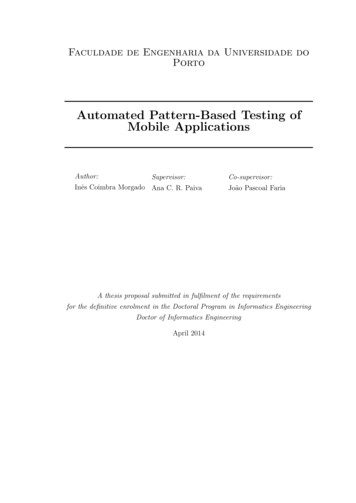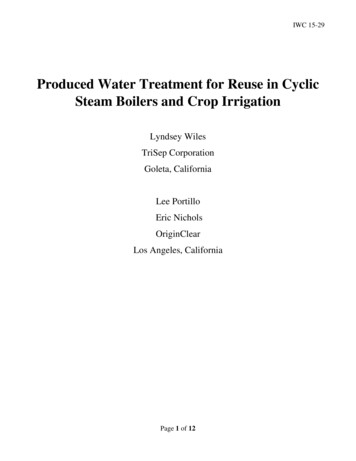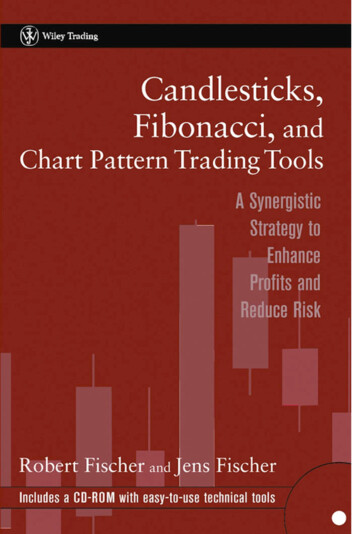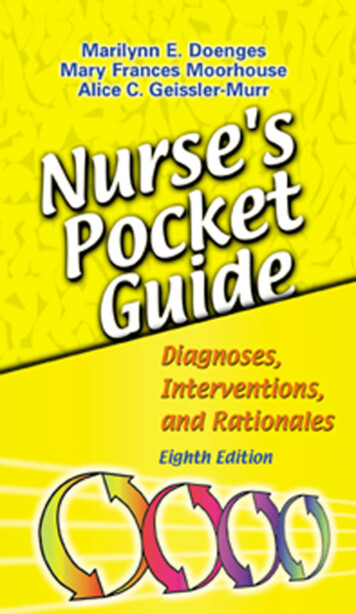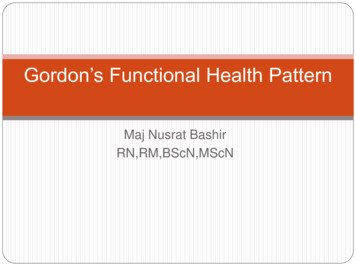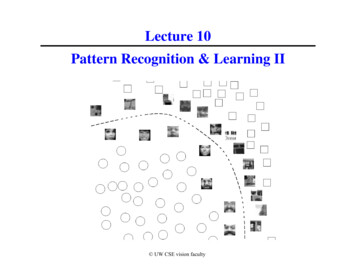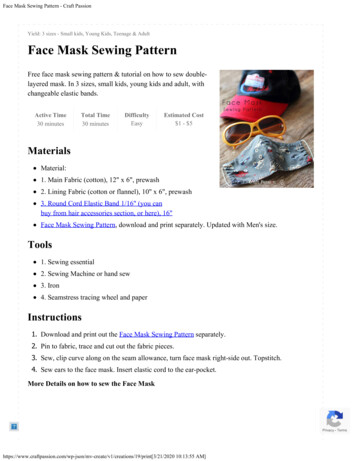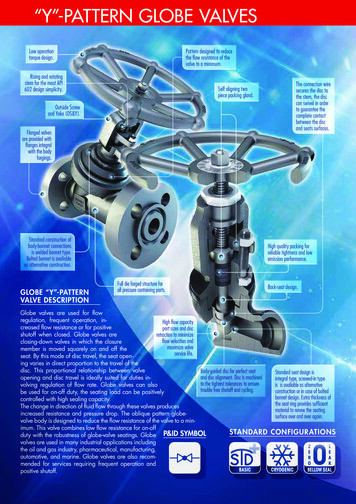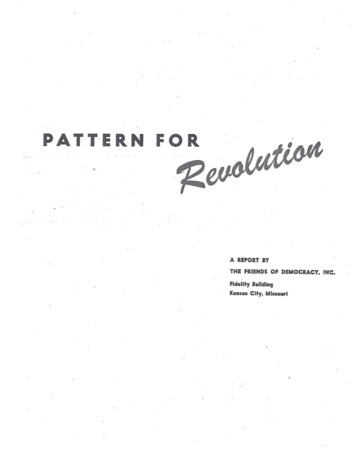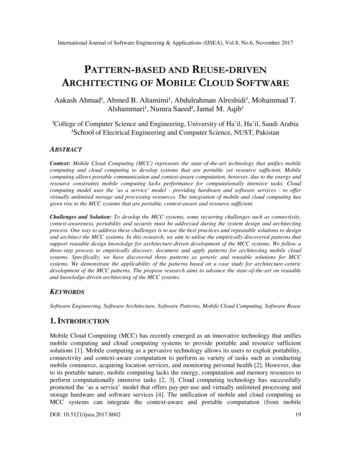
Transcription
International Journal of Software Engineering & Applications (IJSEA), Vol.8, No.6, November 2017PATTERN-BASED AND REUSE-DRIVENARCHITECTING OF MOBILE CLOUD SOFTWAREAakash Ahmad1, Ahmed B. Altamimi1, Abdulrahman Alreshidi1, Mohammad T.Alshammari1, Numra Saeed2, Jamal M. Aqib11College of Computer Science and Engineering, University of Ha’il, Ha’il, Saudi Arabia2School of Electrical Engineering and Computer Science, NUST, PakistanABSTRACTContext: Mobile Cloud Computing (MCC) represents the state-of-the-art technology that unifies mobilecomputing and cloud computing to develop systems that are portable yet resource sufficient. Mobilecomputing allows portable communication and context-aware computation, however, due to the energy andresource constraints mobile computing lacks performance for computationally intensive tasks. Cloudcomputing model uses the ‘as a service’ model - providing hardware and software services - to offervirtually unlimited storage and processing resources. The integration of mobile and cloud computing hasgiven rise to the MCC systems that are portable, context-aware and resource sufficient.Challenges and Solution: To develop the MCC systems, some recurring challenges such as connectivity,context-awareness, portability and security must be addressed during the system design and architectingprocess. One way to address these challenges is to use the best practices and repeatable solutions to designand architect the MCC systems. In this research, we aim to utilise the empirically discovered patterns thatsupport reusable design knowledge for architecture-driven development of the MCC systems. We follow athree-step process to empirically discover, document and apply patterns for architecting mobile cloudsystems. Specifically, we have discovered three patterns as generic and reusable solutions for MCCsystems. We demonstrate the applicability of the patterns based on a case study for architecture-centricdevelopment of the MCC patterns. The propose research aims to advance the state-of-the-art on reusableand knowledge-driven architecting of the MCC systems.KEYWORDSSoftware Engineering, Software Architecture, Software Patterns, Mobile Cloud Computing, Software Reuse1. INTRODUCTIONMobile Cloud Computing (MCC) has recently emerged as an innovative technology that unifiesmobile computing and cloud computing systems to provide portable and resource sufficientsolutions [1]. Mobile computing as a pervasive technology allows its users to exploit portability,connectivity and context-aware computation to perform as variety of tasks such as conductingmobile commerce, acquiring location services, and monitoring personal health [2]. However, dueto its portable nature, mobile computing lacks the energy, computation and memory resources toperform computationally intensive tasks [2, 3]. Cloud computing technology has successfullypromoted the ‘as a service’ model that offers pay-per-use and virtually unlimited processing andstorage hardware and software services [4]. The unification of mobile and cloud computing asMCC systems can integrate the context-aware and portable computation (from mobileDOI: 10.5121/ijsea.2017.860219
International Journal of Software Engineering & Applications (IJSEA), Vol.8, No.6, November 2017computing) with processing and storage services (of cloud computing) to support systems that areportable, yet resource sufficient [3]. Specifically, in the MCC systems, a mobile device can act asa portable and context-sensitive user interface that relies on the backend cloud server to performcomplex tasks such as real-time image processing, context sensing, and human decision support[5]. Despite these benefits, MCC systems entail a number of challenges that relate to thescalability, performance, and availability of the system in a dynamic environment.To engineer and develop the MCC systems, there is a need to replace the ad-hoc and once-offsolutions with reuse-driven and knowledge-based practices for system design. Also, with thegrowing demands for the adoption of the MCC systems, knowledgeable and experiencedsystems’ designers/architects of MCC systems are needed who are not widely available as MCChas just started to emerge as an innovative technology [1, 5]. In this situation, software patternsand styles can provide reusable solutions and best practices to develop MCC systems.Specifically, software patterns focused on designing or architecting MCC can providedocumented and well understood software design solutions to both the experienced and novicearchitects [6, 7, 8]. Software patterns have been proven successful in providing reusable packagesof generic and repeatable solutions to recurring problems of software and system design [9]. Thismeans that patterns capture the concentrated wisdom of practitioners and consolidated designrationale from multiple systems to develop software effectively and efficiently [10]. However,pattern-based architecting is faced with the challenge of empirically discovered patterns that mustbe systematically documented and recurrently applied to the systems under design [11].In this research, we aim to exploit patterns to design and architect mobile cloud systems byincorporating pattern-driven reusability and efficiency in the software design process. To do so,we have followed a three-step process that includes (i) pattern discovery, (ii) patterndocumentation, and (iii) pattern application to architect a MCC system. An overview of theproposed solution is illustrated in Figure 1. In the proposed solution, as in Figure 1, first thepattern sources are investigated to empirically discover patterns and maintain a repository thatacts as a collection of the documented patterns. Finally, the discovered patterns can be selectedand applied to support pattern-based software architecture for the MCC system. This means thatpatterns as generic and reusable solutions create the software architecture – providing the systemblueprint – that acts as a bridge between system requirements and system implementation as inFigure 1. It is vital to mention that, while architecting the MCC systems, one exploitsdynamically composed services to develop systems that are portable, context-sensitive andefficient [7, 8]. In comparison to the more traditional (object-oriented, component-based andservice-driven) systems [10], patterns for mobile MCC architectures are characterized by specificrequirements such as mobility, context-sensitivity for (front-end) mobile computing with servicecomposition, and scalability of (back-end) cloud services [12].20
International Journal of Software Engineering & Applications (IJSEA), Vol.8, No.6, November 2017Figure 1. An Overview of the Proposed Solution.Assumptions and Contributions The proposed research aims to exploit the traditional concepts ofsoftware patterns and apply them to architect innovative solutions such as MCC software. Weaim to support pattern-based architecting that can accelerate the process of gaining design orarchitectural knowledge and applying it for architecture-centric software development. Theresearch aims to advance the research state-of-the-art on MCC systems by focusing onempirically discovered patterns and their applications. The research assumes the existence of thepattern sources that can be investigated to discover new patterns. We also assume patterndiscovery and document as a continuous process that involves frequent discovery of existing andnew sources to discover innovative patterns. This paper provides a significant extension to ourresearch in [6]. In contrast to the catalogue of MCC architectural patterns in [6], in this researchwe provide case study based demonstration of the applicability of the patterns. Moreover, we alsoevaluate pattern-based reusability and efficiency of architectural design process. The primarycontributions of this research are to:– Support a three-step process to discover, document, and apply patterns as reusable solutionsto guide the system design and architecting phases.– Apply the discovered patterns to recurring problems of software design and architecture.Pattern applicability demonstrates reusability and efficiency of tasks involved in the systemdesigning and architecting phases.The rest of the paper is organised as follows. Section 2 presents background details. Section 3presents the related research. Section 4 discusses the research methodology. Section 5 presentsthe discovered patterns. Section 6 demonstrates case study based application of the patterns.Section 7 concludes the paper.2. MCC ARCHITECTURES AND THEIR QUALITY CHARACTERISTICSIn this section, we introduce the software architecture for the MCC systems in Section 2.1. Wealso present the characteristics for the quality of the architectures in Section 2.2. The terms andconcepts introduced in this section are used throughout the paper.21
International Journal of Software Engineering & Applications (IJSEA), Vol.8, No.6, November 20172.1. A LAYERED REFERENCE ARCHITECTURE FOR THE MCC SOFTWARE SYSTEMSIn Figure 2 we have presented a generic architectural view of the MCC systems. Specifically,Figure 2 a) illustrate a reference architecture for the MCC systems that comprises of two layers,(i) Cloud Computing Layer (Back-end), and (ii) Mobile Computing Layer (Front-end) [13].Figure 2 b) presents the component and connector architectural view of the system [14]. Wediscuss about the layered architecture view (Figure 2 a)) and the component and connectorarchitectural view (Figure 2 b)) detailed as below. Both the architectural views presented inFigure 2 a) and Figure 2 b) are complementary to each other. The reference architecture in Figure2 a) provides a generic reference to the system under consideration, whereas, the component andconnector view highlights the required components and their interactions in developed system[13].A) Reference Architecture for the Layering of the MCC SystemsA reference architecture represents the documentation or the structure of a system - as acollection of best practices - that can be referred to during system design to derive advancedarchitectural solutions [13]. The extended details about the reference architectures and their usageare provided in [7, 9, 11]. In Figure 2 a), the reference architecture illustrates two layers of thesystem each of which deals with a specific aspect/functionality of the system. The presentation ofthe reference architecture helps us illustrate pattern-based architecting process, later in the paper.- Front-end - Mobile Computing Layer provides the users with an interface to utilize andinteract with the data and exploit the context-based and location information of the mobile device.In addition to the context sensitivity, mobile computing layer enables mobility and computationon the go. However, due to the increased mobility, an inherent issue with this layers is that mobiledevice(s) lacks computation and storage-intensive resources. Moreover, issues like performanceand data security and privacy must also be addressed.- Back-end - Cloud Computing Layer helps a mobile device to off-load the computationallyintensive tasks and data to scalable and virtually unlimited storage and processing resourcesoffered by the server [1, 5]. Specifically, the cloud-based servers utilise the pay-per-use andvirtually unlimited ‘as a service’ model that provides hardware and software services to be usedby other systems/entities. In Figure 2, the unification of the mobile and cloud computing asmobile-cloud computing enables the users to utilize the features of a mobile device such ascontext-sensitivity, location-awareness and mobility, while enjoying the virtually unlimitedcomputation and storage resources of cloud computing. In order to support such unification, i.e.,integration of the mobile and cloud computing, a continuous network connectivity is required.Network connectivity may involve latency along with security and privacy of data thatcommunicates between mobile and cloud.A) Component and Connector Architectural ViewIn Figure 2 b), we present the component and connector architectural view for the system [14].The component and connector architectural view is composed of architectural components thatact as the elements of computation and data stores for the system. The connectors enable theinteraction between various components.22
International Journal of Software Engineering & Applications (IJSEA), Vol.8, No.6, November 2017The component and connector architectural view is beneficial as it helps to decomposes a systeminto its building blocks, i.e., architectural components. For example, Figure 2 b) that represents asimplified component and connector-based architecture of the system that invokes location-basedservices. The getLocationService component (running on a mobile device) invokes the locationproviding service. The location-based service computes the current location coordinates of theuser with calculateLocationCoord service. Assuming that calculateLocationCoord iscomputation intensive, therefore it is executed on the cloud-based server. Both the componentsare interconnected using locSrv connector.Figure 2. Overview of a Generic Architecture for MCC Systems.2.2. QUALITY CHARACTERISTICS FOR MCC ARCHITECTURESThe quality characteristics or non-functional properties (NFRs) represents the attributes of extrafunctional qualities that a system needs to operate effectively and efficiently. In the MCCsystems, in addition to supporting the core functionality, the characteristics of software qualityare vital for both the mobile computing and cloud computing layers. For the mobile computinglayer of the MCC systems, the main characteristics of the quality include but not limited to:-Context-awareness that refers to the system’s ability to exploit the contextual information tosupport context-aware computing.Mobility aims to support the computation and system level operations in a portable and onthe go fashion.23
International Journal of Software Engineering & Applications (IJSEA), Vol.8, No.6, November 2017-Efficiency means that system is able to operate and produce results efficiently andeffectively.In contrast to mobile computing layer, cloud based systems rely on the principle of serviceorientation that allows service composition to implement cloud-based applications [4, 7].Therefore, the quality of services being composed or provided are central to the performance ofthe cloud architectures. This means that cloud-based services must satisfy the desired qualitycharacteristics. These characteristics include but not limited to-Elasticity refers to the systems that are elastic (i.e., addition or removal of system resources)to accommodate the variations in system’s operational environments.Multi-tenancy means that the system must support multiple tenants for the same servicesprovided by cloud-based systems to the potential requesters.Virtualization means that systems’ resources (i.e., hardware and software services) must bevirtualised for their effective usage.The quality attributes for the MCC architectures are distinct from traditional softwarearchitectures. This means that the patterns for traditional software development and architecture[9, 10, 11] cannot easily be applied to mobile cloud systems unless they support the abovementioned characteristics specific to mobile cloud architectures [7, 8]. For example, a pattern thatexploits context sensing for recommendations and decision support is only applicable to contextaware computing architectures. It is vital to mention that an individual pattern may not ensure allthese characteristics highlighted above, however, a collection of patterns should ensure to addressthem all. For example, unlike the traditional architectures, mobile cloud based architectures areexpected to serve context-aware multiple-tenants with each tenant having its own specific contextand QoS requirement that can vary from performance and reliability to security aspects. Contextaware multi-tenant capabilities of MCC systems need to be considered not only at service but alsoat the platform and infrastructure [7, 8] level not addressed in existing patterns.3. RELATED RESEARCHWe now present the related research that overviews the research state-of-the-art for thearchitecting of MCC systems. First, we discuss the existing patterns for mobile and cloudcomputing architectures in Section 3.1. We then present the related reference architecture andpatterns for mobile cloud based systems. The presentation of the related research and solutionshelps us to define the scope and contributions of the proposed solution.3.1. PATTERNS-BASED ARCHITECTING OF MOBILE AND CLOUD COMPUTING SYSTEMS- Patterns for Cloud-based Architectures: In [15], the authors have presented acomprehensive catalogue of architectural patterns for cloud-based systems. The patternspresented in this work promote recurring solutions and best practices for cloud-based Platform asa Service (PaaS). The patterns address the architectural issues relating to the scalability, big data,fault handling and distributed services on the Windows Azure platform. Patterns in [13] provideguidelines and practical solutions to address the scalability and elasticity in cloud-nativeapplications for Windows Azure platform. The work presented in [16] provides a collection ofpatterns for the development as well as the deployment of the services for cloud-based systems.Specifically, the patterns provide solutions for the (i) development of service models for cloudcomputing (i.e., Software as a Service, Platform as a Service, and Infrastructure as a Service),24
International Journal of Software Engineering & Applications (IJSEA), Vol.8, No.6, November 2017and (ii) deployment of the services (using private, public, hybrid, or community clouds). In [16],the authors have organized the presented patterns as a pattern language that allows thearchitects/developers to select and apply these patterns.It is vital to mention the role of the research communities to provide a common platform orrepositories of newly discovered patterns that are published and made available publicly. Patterncommunities can provide concentrated wisdom and knowledge for system architecting that can bereused to tackle the emerging challenges of system design. In the context of community-drivenpattern repositories, the work presented in [17, 18] represents repositories of architectural patternsfor cloud-based systems. The Cloud Computing Design Patterns in [17] presents a catalogue ofpatterns that address the challenges of scalability, reliability, security and monitoring basedsolutions for cloud applications. In a similar solution [18], referred to as Cloud Design Patterns[16] present a catalogue of patterns that is created by architects based on the type of systemdesign challenges, and their generic solution(s) as design patterns.- Patterns for Mobile Computing Systems: In contrast to the research and developmenton cloud computing patterns, there is a lack of research patterns and pattern-based architecting ofthe mobile computing systems. In a recent research in [8], some architectural patterns arepresented to support the operations of resource constrained mobile devices. Specifically, threearchitectural patterns namely data source integration, group-context awareness, and cyberforaging are presented for mobile computing systems in the context of tactical-edge resourceconstrained environments. These pattern-based solutions support first responders and militarypersonnel that operating in edge environments that are driven by flexibility, resource efficiency,and usability, which are key quality attributes for systems at the tactical edge. The patterns enablethe architects to reuse best practices for system design and architecture while considering both thefunctional and quality requirements of the system. In [19], the authors have presented a collectionof architectural solutions that are referred to as mobility patterns. Mobility patterns have beendiscovered by analysing the successful development of various mobile applications. Mobilitypatterns can empower the designers/architects to reuse design rationale and elements as buildingblocks to engineer and develop new mobile applications.In comparison to the research state-of-the-art on pattern-based architecting of the cloud [13, 15,16, 17, 18] and mobile computing systems [8, 19], the proposed patterns support architecturebased engineering and development of the MCC systems. Our research aims to establish acatalogue of architectural patterns - as a continuously evolving repository of patterns - based ondiscovery and specification of new architectural patterns guided by [16, 20]. We also demonstratethe usefulness of patterns in terms of reusability and efficiency of the architectural designprocess.3.2. PATTERNS FOR MOBILE CLOUD COMPUTING SYSTEMSIn recent years, some reference architectures and pattern-based solution have emerged to supportservice oriented architecture (SOA) for mobile computing [7, 21, 22]. In the following, wediscuss both the reference architectures and patterns for MCC systems, whereas the technicaldetails and the distinction between the two can be found in [23].- Reference Architectures for MCC Systems: In the MCC systems, off-loadingcomputationally intensive tasks from a mobile device to the cloud-based server is a challengingtask. To support the off-loading, [7] presents a reference architecture that supports the off25
International Journal of Software Engineering & Applications (IJSEA), Vol.8, No.6, November 2017loading of computational/memory-intensive tasks to cloud-based servers for the mobile devicesthat operate in hostile environments. The proposed reference architecture in [7] is used todemonstrate some implementations scenarios as well as the architectural trade-offs for thedevelopment of MCC systems. Another reference architecture is proposed in [21] that aims tosupport the first responder teams and their coordination. The reference architecture aims tosupport the development of group-context-aware mobile applications that exploits contextualinformation from individuals and their team members to enable context-aware computing andteam coordination.- Patterns for Mobile SOAs: To support software services or specifically SOAs for mobilecomputing six architectural patterns are presented in [12]. These patterns are named as,standalone, full offloading, partial offloading, SaaS-based, CaaS-based, and offloaded CaaSbased is presented. These patterns support both the functional and quality requirements for themobile-based SOAs. The patterns aims to support the quality attributes that include but are notlimited to the performance, efficiency and energy consumption for mobile applications.Figure 3. Overview of the Research State-of-the-Art and Proposed Contributions.Figure 3 illustrates a high-level overview of different research domains and their overlaps. Basedon Figure 3, we can conclude that our research proposes to contribute towards promoting patternbased architecting for the MCC systems that currently lacks in the existing research. The researchand solution presented in [7, 22, 21] on reference architecture and patterns [23] is relevant to ourproposal. However, by considering the scope of existing research and the recent challenges formobile computing [1, 2, 5, 12], we claim that the proposed solution aims to advance the researchstate-of-the-art on patterns and architectures that can be applied to MCC systems.4. RESEARCH METHOD AND PROPOSED SOLUTIONWe now present the research method the details the methodological steps to conduct thisresearch based on the proposed solution in Figure 4. We use Figure 4 to detail themethodology and proposed solution.26
International Journal of Software Engineering & Applications (IJSEA), Vol.8, No.6, November 2017Figure 4. Research Methodology and Solution Overview.As illustrated in Figure 4, the methodology for pattern-based architectural developmentcomprises of three main processes namely pattern discovery, pattern documentation andpattern application. We also highlight the required inputs and outputs for each of theprocess. We discuss the first process of pattern discovery here, while the other twoprocesses are detailed in subsequent sections of the paper.Pattern Discovery Process – As presented in Figure 4, pattern discovery is the initialprocess that involves investigating the sources of patterns (i.e., logs and pattern files) todiscover the recurring solutions as architectural patterns [20]. Specifically, we appliedthe design review method [24] to discover patterns, i.e., by reviewing recurring designsolutions to frequent problems of architecting MCC systems. Our design review teamwas comprised of 3 members with an extensive experience of (a) conducting thesystematic review, (b) pattern mining, and (c) development of mobile and cloud systems.The design review team followed the following steps to discover the patterns.Step I – Review of Architecture Based Challenges and Solutions for MCC Systems: The designreview was conducted to investigate the recurring challenges, design problems and existingsolutions to develop mobile cloud architectures [25]. A systematic review of the existingsolutions follows evidence based software engineering method [22] to minimize the bias andthreats in the review. To conduct the design review objectively, we outlined a number ofResearch Questions (RQs), detailed below. Based on the research questions and available data weselected 85 solutions (problem-solution map) as the primary sources of pattern discovery.RQ1 – What methods/techniques/frameworks/solutions are provided in existing (research andpractices) to model/develop/evolve MCC system architectures?Objective(s): The objectives of this RQ was to identify and understand the recurring challengesand their architectural solutions for the design and development of the MCC systems.27
International Journal of Software Engineering & Applications (IJSEA), Vol.8, No.6, November 2017RQ2 – What are the patterns/styles/frameworks to support reusable design knowledge forarchitecting MCC systems?Objective(s): The objectives of this RQ goes beyond analysis of architectural solution to focusprimarily on the discovery of reusable design knowledge that can be used frequently asarchitectural patterns.Step II – Identification of Pattern Data Sets: Once we have identified and reviewed thearchitectural solution based on the RQs, we extracted the relevant data from the solutions as inTable 1. The datasets here refer to existing architectural challenges, solutions, and theirvalidations. Table 1 acts as a structured template to capture and maintain pattern related data in asystematic manner. Based on the design review process [24], we derived 7 data items that arelisted in Table 1 (I1 to I7 – the collection of data items is referred to as datasets) by following theguidelines in [24] and our experience with the discovery of architectural pattern mining [18] Thedata items in Table 1 helped the team to objectively review and systematically extract theproblem (P) and solution (S) mapping, the attributes (A) that affect the solution and theoccurrence frequency (T) of the repeatable solution by analyzing the pattern datasets. Once adecision (D) is reached, the results are documented as pattern elements (E) for a peer-reviewbefore finalization.Table 1. Dataset Items for Pattern Discovery ProcessIDI1I2I3ItemsDesign Space (C)Recurring Problem (P)Frequent Solution (S)DescriptionAll the available architectural design (C 85 studies).Repeatable problems existing in the design space (P C).Solutions to repeatable problems in the design space (S C).Threshold Threshold for occurrence of S to be discovered as a patternI4Frequency(T)I5Design Attributes (A)I6Discovered Pattern (N)I7Pattern Elements (E)Attributes affecting S (A 08)Context Awareness, Mobility, Computational Efficiency,Energy Efficiency, Service Reliability, Service Availability,Data Storage, Data Processing2 Yes, 1 Not sure (consensus required), 0 NoElements of Pattern Description (E 9)Name, Intent, Problem (P), Solution (S), Impact, Origin,Uses, Reference Diagram, Architecture Elements,ConstraintsStep III - Thematic Analysis based Investigation of the Datasets: After identification of thedatasets, and extraction of the data items, finally thematic analysis is performed. Thematicanalysis aims to ‘identify, analyse and report’ recurring solutions as potential patterns fromdatasets. A theme is a frequent solution or a method that aims to address recurring issues.(A) Data Analysis process comprises of (a) analysing datasets, (b) to extract design attributesfrom problem-solution mapping (I5 in Table 1).(B) Pattern Discovery process involves (a) searching of the recurring themes based on dataanalysis, and (b) reviewing the identified themes. To discover patterns, we reviewed studies28
International Journal of Software Engineering & Applications (IJSEA), Vol.8, No.6, November 2017and aimed at discovering design problems (I2) and their relate solutions (I3). We consider arecurring theme as a discovered pattern (I6).(C) Pattern Documentation is the last process that includes (a) classification of relatedthemes based on design attributes (I5) and documented them in a template (I7).5. TEMPLATE-BASED DOCUMENTATION OF ARCHITECTURE PATTERNSAfter the discovery of the patterns, pattern documented is required to maintain the details of thepatterns that can be looked-up whenever required to understand and utilise a pattern. Patterntemplate represents a structured document that provides the necessary elements to capture andrepresent the individual patterns in a systematic way to support pattern understanding and usage[9, 11]. In this section, first we introduce the pattern template and then demonstrate templatebased documentation of the discovered patterns. In
three-step process to empirically discover, document and apply patterns for architecting mobile cloud systems. Specifically, we have discovered three patterns as generic and reusable solutions for MCC systems. We demonstrate the applicability of th
